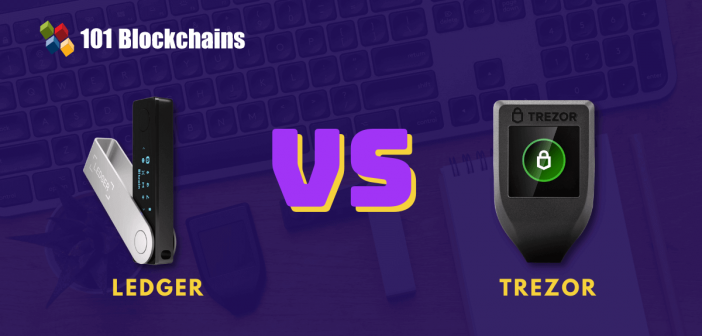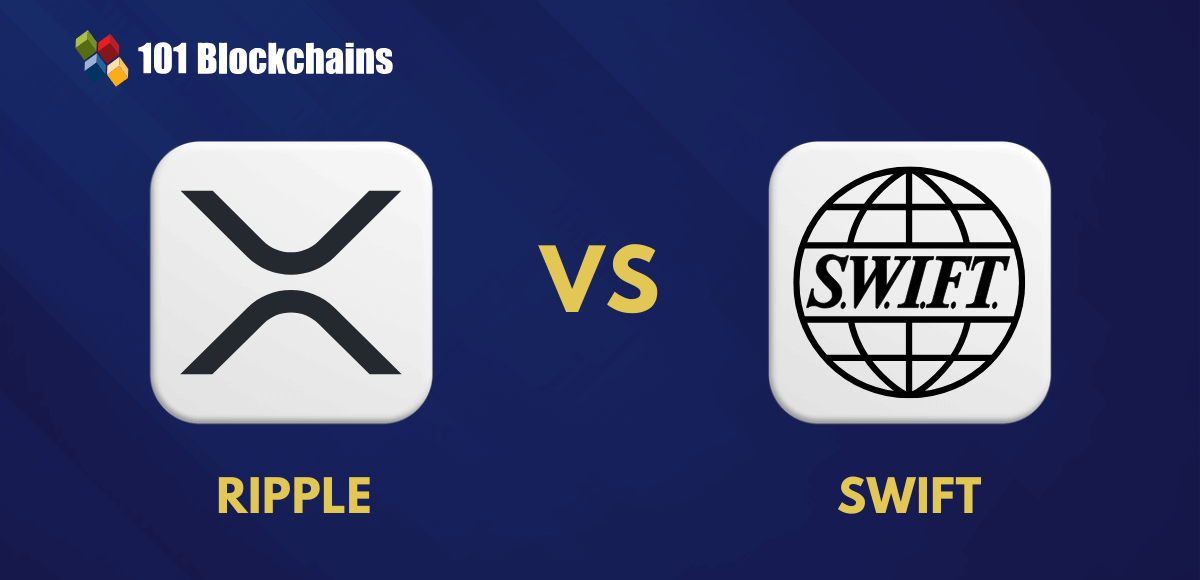Learn how blockchain truly works, master key definitions, and uncover what makes smart contracts so "smart." Dive into the fundamentals, gain valuable insights, and start your blockchain journey today!

Comparisons
James Howell
on April 22, 2022
Ledger vs Trezor – Hardware Wallet Comparison
The widespread use of cryptocurrencies all over the world has obviously caught the attention of millions of people worldwide. Businesses, governments, and individuals are exploring different possibilities in the crypto ecosystem for the assurance of promising value improvements. However, one of the vital aspects of the use of cryptocurrencies obviously refers to wallets. If you have been following the crypto space closely, you must have come across the Ledger vs Trezor comparison on many occasions. Both of them are top hardware wallets with unique sets of functionalities.
On the other hand, people who are new to crypto often encounter difficulty in choosing a suitable option from the two top contenders. Therefore, you must know the differences between Ledger and Trezor hardware wallets to choose the ideal option to store your cryptocurrencies. The following discussion offers a detailed Trezor vs Ledger comparison on the basis of various critical points of difference.
Want to become a Cryptocurrency expert? Enroll Now in Cryptocurrency Fundamentals Course
What are Hardware Wallets?
Before you start the Ledger wallet vs Trezor wallet comparison, you must have a clear impression of crypto wallets and hardware wallets. If you have decided to buy some cryptocurrencies, where will you store them? The crypto wallet is just like the physical wallet you use for storing cash and credit cards. However, the crypto wallet does not store the actual cryptocurrencies. On the contrary, it serves as a repository for the private keys or backup phrases required for crypto transactions. The two most common categories of crypto wallets include software wallets and hardware wallets.
The common examples of software wallets for crypto, such as Coinbase and Gemini, require an internet connection. You can think of software wallets and web or mobile applications that serve as crypto wallets. As a matter of fact, software wallets are more likely to take control of your private keys. In this case, hardware wallets present a better alternative. Hardware wallets are basically physical devices used for storing your cryptocurrency’s private keys.
Get familiar with the terms related to cryptocurrency with Cryptocurrency Flashcards
Working of Hardware Wallets
Now that you know about the basics of a hardware wallet, you must know about its works before drawing out an in-depth hardware wallet comparison for all available choices. The primary function of hardware wallets is the storage of private keys. You can add another layer of security with a PIN to access the hardware wallet. Users can connect the hardware wallet to the internet when they have to sign or confirm transactions.
Most important of all, hardware wallets keep the private keys to your cryptocurrency away from the internet, thereby ensuring safety. However, you should also pay attention to the seed phrase generated for the hardware wallet. Users must write down the seed phrase and store it in a safe place as it can help in regenerating the private key in the event of losing the hardware wallet.
What is Ledger Hardware Wallet?
Ledger is a crypto hardware wallet provider with many popular offerings, including the Ledger Nano X. The hardware wallet has been developed with a custom operating system known as the Blockchain Open Ledger Operating System. As of now, the Ledger Nano X supports more than 1,100 cryptocurrencies through the Ledger Live app.
What is Trezor Hardware Wallet?
Trezor is another crypto hardware wallet solution offered by SatoshiLabs. The most popular offering in hardware wallets with Trezor Model T is a promising choice for innovative functionalities. The Trezor hardware wallet features open-source firmware and software. At the same time, the Trezor Model T supports over 1200 different cryptocurrencies, thereby enabling easier management of cryptocurrencies.
Start learning about Cryptocurrencies with World’s first Cryptocurrency Skill Path with quality resources tailored by industry experts Now!
Differences between Ledger and Trezor Hardware Wallets
Ledger and Trezor are obviously the two top players in the hardware wallet industry. They offer secure storage for your cryptocurrencies with support for more than 1000 coins. You can find enthusiastic supporters of both hardware wallets. For example, the new Trezor Model T has come up with a larger touchscreen. On the other hand, the Ledger Nano X offers Bluetooth connectivity and a mobile app. Therefore, a detailed overview of the Ledger vs Trezor comparison can help you choose the ideal choice for your cryptocurrency requirements.
Here are some of the notable pointers for comparing the two most popular crypto hardware wallets.

Please include attribution to staging2.staging2.101blockchains.com with this graphic. <a href='https://staging2.staging2.101blockchains.com/blockchain-infographics/'> <img src='https://staging2.staging2.101blockchains.com/wp-content/uploads/2022/04/Ledger-vs-Trezor-Hardware-Wallet-Comparison-1.png' alt='Ledger vs Trezor='0' /> </a>
-
Support for Cryptocurrencies
One of the foremost factors in a comparison between Ledger hardware wallet and Trezor wallet is the support for cryptocurrencies. You would obviously look for a hardware wallet that lets you use different cryptocurrencies without any limitations. In this case, Ledger has the upper hand with support for over 1800 different cryptocurrencies and tokens.
On the other hand, Trezor supports around 1649 coins and tokens. You can find an additional advantage with Ledger in a Trezor vs Ledger wallet comparison with the support for tokens such as Uniswap, Graph Token, Yearn Finance Token, or Avalanche. Therefore, Ledger turns out as a promising choice for any crypto user interested in exploring the DeFi landscape.
Curious to know the impact and in-depth understanding of crypto compliance in businesses? Enroll now in Crypto Compliance Fundamentals Course.
-
Ease of Use
The next crucial factor in a Ledger wallet vs Trezor wallet comparison is the ease of use. You are less likely to go for a hardware wallet that is difficult to use. Interestingly, both the Ledger and Trezor hardware wallets have been tailored for beginners as well as expert users. You have to follow some common steps for using both hardware wallets, such as updating the firmware of the device and creating the wallet.
In addition, you have to create the backup seed phrase and set a PIN for the hardware wallet. While both the Ledger and Trezor hardware wallet offer simple setup processes, Ledger needs you to install the Ledger Live app. On the other hand, the Trezor wallets work through a web-based interface.
Most important of all, the design improvements in Trezor offer it a plausible advantage in a Trezor vs Ledger comparison. The larger screen and web interface of the latest Trezor Model T make it more intuitive and easier to use. In addition, you don’t have to install an app for each cryptocurrency you want to use with the Trezor wallet. On the contrary, Ledger needs you to install a specific app pertaining to the cryptocurrency you want to use.
-
Features
One of the significant points for comparing Ledger and Trezor hardware wallet also brings you across features. Both Trezor and Ledger are top contenders among crypto hardware wallets and offer almost similar features. However, the subtle differences in the design of the hardware wallets can help you differentiate between the two top choices.
The Ledger hardware wallet features a sleek design similar to a regular USB storage device. On the other hand, Trezor wallets are lighter in weight and feature unique shapes with plastic casings. Ledger gains the upper hand in features again by offering support for iOS devices, a feature unavailable in Trezor wallets.
The hardware wallet comparison in terms of features turns in favor of Trezor for its larger display. You can notice the differences between the displays of Ledger and Trezor hardware wallets by reflecting on the top models by each company. For example, the Ledger Nano X features an OLED display with a 128×64 pixels resolution. On the other hand, the Trezor Model T offers a 240×240 pixels LCD color touchscreen.
Ledger stays strong in the Trezor vs Ledger debate on the grounds of features with the optional Bluetooth connectivity. As of now, Trezor does not offer the feature of Bluetooth connectivity on any of its devices.
Curious to learn about blockchain implementation and strategies? Enroll Now in Blockchain Technology – Implementation And Strategy Course
-
Security
Security is obviously one of the formidable pointers for discovering the ideal choice in a Ledger vs Trezor debate. As the top hardware wallets, both of them offer industry-leading security for cryptocurrencies with private keys residing on the devices. However, the basic design and operations of both wallets have different implications for the security of your crypto assets.
First of all, you need to know that Trezor utilizes a single chip base in the design of hardware wallets. On the other hand, Ledger utilizes a double chip base, where the second chip is a financial-grade Secure Element chip. The Secure Element chip ensures additional security for a user’s cryptocurrencies against hardware attacks.
However, the Ledger wallet vs Trezor wallet comparison in terms of security does not tilt completely towards Ledger. While Ledger uses the open-source Blockchain Open Ledger Operating System, it uses closed-source firmware. As a result, you cannot find any scope for testing vulnerabilities in any Ledger hardware wallet model. On the other hand, Trezor has many setbacks when it comes to security.
For example, users have to enter the password in Trezor wallets through the company’s keyboard. In such cases, the chances of your password being compromised with a keylogger increase by humongous margins. However, you don’t have to worry about such issues in security with Ledger wallets, as they require users to enter the PIN directly on the device.
Recently, the Trezor Model T has introduced support for the Shamir Backup, thereby improving the scope for private key security. On the other side, Ledger has experienced security breaches that have reduced the trust of users in the hardware wallet.
-
Mobile App
The final aspect of the hardware wallet comparison between Ledger and Trezor would focus on the facility of a mobile app. You must have noticed how the Ledger Live app is an essential requirement for using Ledger wallets. Users can download the app on their mobile or desktop devices. The Ledger Live app helps them check crypto balances in real-time alongside sending and receiving funds. However, Trezor does not have a mobile app right now, and users access the hardware wallet through a web-based interface.
Learn the fundamentals, working principle and the future prospects of cryptocurrencies from Cryptocurrency Fundamentals E-book
Final Words
The final overview of the Ledger vs Trezor comparison offers a credible ground for evaluating their use for different objectives. Cryptocurrencies offer a wide range of opportunities, and users may have different requirements for storing and managing their crypto. Hardware wallets are a trustworthy choice for secure storage and management of crypto assets.
However, a comparison between the two top hardware wallets shows that both of them have many differences. Ledger and Trezor offer user-friendly and secure hardware wallets with some distinct value benefits. For example, Trezor features a larger and more colorful touchscreen, while Ledger offers the benefit of Bluetooth connectivity. Evaluate both the top choices among hardware wallets right now before you select one for your ventures in crypto.
*Disclaimer: The article should not be taken as, and is not intended to provide any investment advice. Claims made in this article do not constitute investment advice and should not be taken as such. 101 Blockchains shall not be responsible for any loss sustained by any person who relies on this article. Do your own research!






